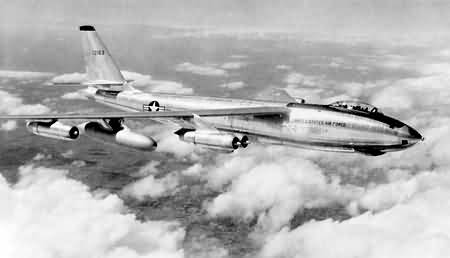10/31/2010. The Model 450-11-10 B-47B was the first true production B-47, and enough improvements were made during the production of 399 examples to justify the use of additional model numbers, 450-67-27 for the 88th to 289th with 5,800 lb (2,631 kg) st General Electric J-47-GE-23 engines and 450-157-27 for the 290th and on.
Empty weight was 76,130 lb (34,532 kg) and gross weight was 180,000 lb (81,647 kg).Top speed was 617 mph (993 kmh) at 10,600 ft (3,231 m). In addition to the two 0.50 in (12.7 mm) tail guns, which could be fired by the co-pilot (who was also called the weaponeer) or by the radar system, the B-47B carried two K-38 cameras, one K-17, and one K-72.
When the WW II Boeing-Lockheed-Douglas pool was re-established for B-47 manufacture, Boeing supplied aircraft parts and technicians to help the other two firms get started. Lockheed turned out eight B-47Bs with USAF serial numbers assigned to Boeing, while Douglas produced ten. B-47Bs underwent considerable modification and redesignation:
DB-47B. Armament deleted and fitted with radio for controlling QB-47s and other remotely-controlled craft.
YDB-47B. Modified in 1953 to carry a Bell GAM-63 Rascal missile, which was guided to the target by a controller in the same B-47 after the missile was released.
RB-47B. Photo-reconnaissance conversion with eight cameras in a heated capsule in the bomb bay.
TB-47B. Transition trainers for pilots and navigators were developed from standard B-47Bs by adding a fourth crew position for an instructor.
WB-47B. Weather-reconnaissance conversion.
B-47B-II. Modified and brought up to B-47E standard.
XB-47D. Unarmed flying test bed for Wright YT-49-W-1 turboprop engine
XB-56, later YB-56. Intended for conversion with four Allison J-71 engines and reconnaissance equipment in place of bombs. This was redesignated YB-47C, but was cancelled before flown, along with projected RB-56A versions.
